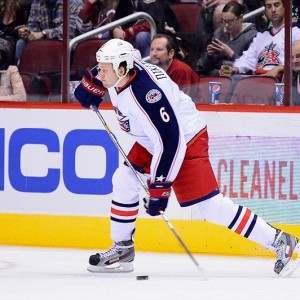On the Oct. 3, 2015, the Edmonton Oilers placed Nikita Nikitin on waivers for the purpose of assigning him to the American Hockey League. The following day, Nikitin, after becoming available to all 30 NHL teams, had gone unclaimed, and has since been assigned to the Bakersfield Condors of the AHL.
The move, although not entirely surprising, furthers a major paradigm shift occurring within the Oilers roster, a shift characterized largely by the departure of existing Oilers players acquired by the former Oiler management group, led primarily by Craig MacTavish and Kevin Lowe.
As a result, Nikitin is simply the newest casualty of both the new and improved Oilers management group, as well as increasingly young, developing defensive talent.
However, the original decision to acquire Niktin can surely be seen as nothing less than what it truly was, a gamble.
The Gamble
With a once proud and successful franchise floundering, Oilers management in the summer of 2014 remained in a rush not only to improve their roster, but also to return to the playoffs, and as a result continued to overlook the importance of asset development. As such, gaping holes, especially on the blue line, were hurriedly filled with players of inconsistent abilities and skill, a select number of which had never truly illustrated value on NHL ice.
One of such moves was the addition of Nikitin, who was acquired in exchange for a fifth round pick and was subsequently signed to a massive, two-year, $9 million contract extension in hopes of improving a perpetually poor Oilers blue line.

In his previous contract with the Columbus Blue Jackets, Nikitin was signed to a two-year contract worth $4.3 million, with a more realistic cap hit of $2.1 million. However, somewhere in between his 104 games, 24 points, and 48.2 percent Corsi For Percentage (CF%) with the Blue Jackets, Nikitin had somehow earned a $2.35 million annual pay raise with the Oilers.
In relation to NHL defenders of similar cap hits, Niktin’s $4.5 million rate in 2014-15 was greater than the likes of, to name a select few of many, Kevin Shattenkirk, Mark Giordano, Cam Fowler, Marc-Edouard Vlasic, Roman Josi and Victor Hedman.
Given his substantially improved cap hit, the Nikitin signing was expected to bring composure and consistency to the Oilers blue line. However, the Oilers instead received much, much less than they anticipated.
In his first, and quite possibly his last season in Edmonton, Nikitin laid a dud, playing in a mere 42 games due to injuries, while recording four goals and 10 points. In those games, Nikitin’s CF% remained similar to his career average, finishing the season at 48.8 percent. However, Nikitin’s Opponent Corsi For per 60 Minutes (OppCF60), was much higher, at 54 percent, indicating Nikitin allowed more shot attempts per game against than for while on the ice.
A Definitive Decision
Realistically, it should come as no surprise that the Oilers chose to place Nikitin on waivers. As we have seen, not only was Nikitin overpaid by then Oilers management from the outset considering his on-ice abilities, but his place on the Oilers roster had become increasingly infringed upon by a rising number of younger, generally more talented defenders.
D-man Nikita Nikitin, with nearly 300 #NHL games, has been assigned to #Condorstown. READ >> http://t.co/LLpqZKZIuN pic.twitter.com/3zEx3xzswB
— Bakersfield Condors (@Condors) October 4, 2015
In demoting Nikitin, the Oilers made a definitive and concise decision, as they will not only be able to provide one of their younger defensive prospects, most likely Brandon Davidson, an opportunity to establish himself at the NHL level, but they will also be able to bury a percentage of Nikitin’s cap hit in the AHL, providing the Oilers with greater flexibility within their NHL roster.
The Oilers’ decision to trade for and re-sign Nikitin to a contract extension was simply a gamble which, unfortunately for the Oilers, failed to pay off. In attempting to rush their rebuild, Oilers management in 2014 made a rash decision which, unknowingly, would negatively impact the team in the present day.
At the time, it would have been strictly impossible to have predicted this outcome. However, by conducting a brief analysis of Nikitin’s on-ice capabilities and NHL playing history, it is in reality quite clear that Nikitin was never truly worthy of the lucrative NHL deal the Oilers offered him little over a year ago.
As a result, Nikitin has become one of the Oilers’ most recent gambles which failed to pay off, a gamble which was in reality a necessary, yet uncalculated risk in hopes of fast-tracking an early return to the Stanley Cup playoffs for the “City of Champions.”